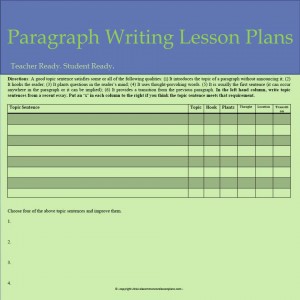How to Organize a Paragraph: Teaching Paragraph Development Made Easy
Master the paragraph and you’ve mastered the essay. Good ideas can be made emphatically and clearly with well positioned, ordered, and developed paragraphs. These suggestions will help you write and teach better paragraphs.
An Olympic Moment
I received this letter from a former student:
Dear Teacher:
You may not remember me. I swam in high school and did pretty well. I got bored my sophomore year and decided to quit. My Speedo, swim goggles, and cap were in my backpack and ready to turn in right after your class. You gave a lesson on methods of paragraph development, varying paragraph lengths, and using different ways to organize a paragraph. Your lessons on writing a paragraph changed my life. Instead of quitting, I varied the length of my swims and developed different swim strokes. I think you should share these gold medal winning tips on writing a paragraph, methods of paragraph development, and varying paragraph length with the world.
Sincerely,
Michael
This Olympic-sized plea will not go unheralded.

Go for the gold with the Paragraph Teaching Guide. It contains 10 lesson plans aligned to the common core standards, notes for each lesson, and over 15 ready-to-use graphic organizers and handouts. It’s only $5.95. Get a sample topic sentence lesson plan from the guide for free. (AP Photo/Mark J. Terrill)
Free Topic Sentence Lesson Plan
Common Core Standards
Teaching the methods of paragraph development satisfies the following common core standards and establishes the basis for teaching all the common core standards in writing for all grade levels.
- W.9-10.1 Write arguments to support claims in an analysis of substantive topics or texts, using valid reasoning and relevant and sufficient evidence.
- W.9-10.1a Introduce precise claim(s), distinguish the claim(s) from alternate or opposing claims, and create an organization that establishes clear relationships among claim(s), counterclaims, reasons, and evidence.
- W.9-10.1b Develop claim(s) and counterclaims fairly, supplying evidence for each while pointing out the strengths and limitations of both in a manner that anticipates the audience’s knowledge level and concerns.
- W.9-10.2b Develop the topic with well-chosen, relevant, and sufficient facts, extended definitions, concrete details, quotations, or other information and examples appropriate to the audience’s knowledge of the topic. W.9-10.2a Introduce a topic; organize complex ideas, concepts, and information to make important connections and distinctions; include formatting (e.g., headings); graphics (e.g., figures, tables); and multimedia when useful to aiding comprehension.
- W.9-10.3c Use a variety of techniques to sequence events so that they build on one another to create a coherent whole.
- W.9-10.4 Produce clear and coherent writing in which the development, organization, and style are appropriate to task, purpose, and audience.
- L.9-10.1 Demonstrate command of the conventions of standard English grammar and usage when writing or speaking.
- L.9-10.1a Use parallel structure.
 Start with the Basics
Start with the Basics
Start with the basics and build from there. Share the following information.
- Write the topic sentence first. You don’t need to have the topic sentence first, but why make your life difficult? Writing the topic sentence first helps the writer (and the reader) focus.
- Generalizations should exist only in the topic sentence. Each paragraph needs to make one point. If you’re having trouble focusing on one main point, write a limiting sentence after the topic sentence to narrow the topic.
- Each paragraph should contain only one main idea.
- Do not worry about transitions in the first draft. Do worry about them in the second draft.
- Organize your information logically. This is done most effectively during pre-writing.
Note: Special thanks to Schaum’s Quick Guide to Essay Writing for helping me organize this section.
Give an Overview of the Different Methods
When writing a paragraph the author should organize it using one of the following methods:
- General to Specific: Start with a generalization and follow it with specific examples.
- Specific to General: Start with specific examples and finish with a generalization.
- Order of Importance: Paragraphs can begin with either the most important idea first or the least important idea first.
- Chronological: Order facts according to when they occurred.
- Spatial: Very effective for description, spatial order moves directionally.
- Order of Familiarity: Knowing the audience is critical for this method of organization. The paragraph can begin with either the least familiar or most familiar concept.
Once students understand they don’t have to write each paragraph the same and have a list of different techniques, you’ll start getting higher quality paragraphs (in theory, at least).
Paragraph Length and Sentence Position
Share the following to help students produce better structured paragraphs.
- Paragraph length varies. Each paragraph must be long enough to cover the main point, anywhere from one sentence to one page. As with sentence length, varying paragraph length provides better rhythm and helps the author emphasize important points.
- When writing paragraphs, knowing where to put each sentence clarifies important points. As a rule, the first sentence holds the strongest position, the last sentence holds the second strongest position, and the middle sentences hold the weakest position.
- Varying sentence lengths helps emphasize your most important points. This is important. Putting one short sentence, for example, in between two long sentences, makes the middle sentence more powerful.
Paragraph Development Lessons
For assignments not involving revision, try the following:
- Instruct students to take notes on the above material.
- Place students in groups of four.
- Assign each group a topic.
- Each person in the group should write about the topic using one of the aforementioned ways to organize a paragraph.
- Students will decide which method of paragraph development is most effective, second most effective, etc.
- Students will share at least one paragraph and explain why that method is most effective, making note of the type of writing used (persuasive, informational, narrative) and the purpose of the paragraph (persuade, entertain, or inform).
- Compete in a paragraph challenge.
If you wish to use student drafts to teach about writing a paragraph, try the following:
- Present the information above.
- Instruct students to analyze each body paragraph of an essay by identifying the method of organization, the length of each paragraph, the number of main ideas per paragraph, the topic sentence of each paragraph, and whether or not the paragraph does its job.
- Make necessary changes based on the above information.
- If working in groups, have students analyze each other’s paragraphs.
After you teach this, you can sit back and accept accolades from your administrators and colleagues for having so many students master writing common core standards.
Lessons on Paragraph Writing
Here are some more lesson plans and lesson ideas for writing paragraphs. Each lesson plan contains discussion/notes information, lesson procedures, and a list of ELA Common Core Standards in case your administrator shows up.
- Writing Topic Sentences
- Teaching Paragraph Structure
- Using Transitions Effectively
- Paragraph Challenge
- The Methods of Paragraph Development
- Using Supporting Details Effectively
- How to Revise and Grade an Essay

Last Updated on October 20, 2017 by Trenton Lorcher
Share This:
 Start with the Basics
Start with the Basics